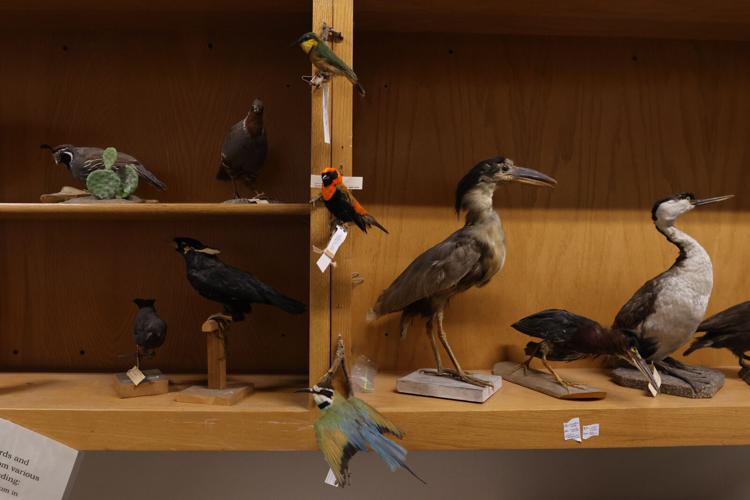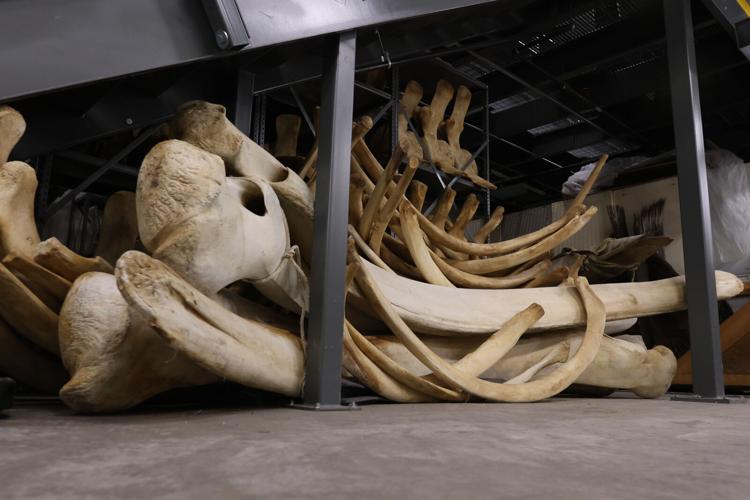
James Porter, president of the Friends of the Georgia Museum of Natural History and retired ecology professor at the University of Georgia, poses for a portrait in the museum’s annex in Bogart, Georgia, on Tuesday, March 26, 2024. (Photo/Liz Rymarev)
A pink fairy armadillo. The 200-pound jaw bone of a humpback whale. An ancient giant sloth. The DNA of a bat species thought to be extinct. One of the most extensive coral collections in the world.
These specimens, and millions more, are part of the University of Georgia’s Museum of Natural History, the state’s official natural history museum. But most students have never heard of the warehouse off Atlanta Highway that hosts just some of the museum’s biological collections, hidden in drawers and tucked away in boxes.
The museum’s space on campus, known as the exhibit gallery on the corner of East Campus Road and Cedar Street, is marked by a whale and shark sculpture attached to the Computing Services Building. But the museum is much more than meets the eye, hosting collections of national and international scientific significance, scattered on and off campus.
The museum’s friends, staff and students say it’s time the museum gets the recognition and space it deserves, and efforts are underway for a new building that is big enough to display all the museum’s collections.
James Porter is the president of the Friends of the Georgia Museum of Natural History and taught ecology at UGA for more than 40 years.
Georgia’s largest collections
The museum is made up of 11 major collections that hold about 7.2 million objects and specimens, but no one knows the exact number of specimens across all collections.
“It’s a good estimate. It’s probably an old estimate… it’s quite a bit more [now],” Bud Freeman, the museum’s current director, said of the 7.2 million figure.
The collections include insects, archaeological artifacts, plant samples, geology collections, reptile and amphibian specimens, fish, invertebrates, mammals, fungi, birds, skeletons and more.
Specimens come from private donations, biologists’ field work, government seizures of illegal specimens and reported animal deaths. Some specimens are thousands of years old or came to the museum decades ago. The museum’s first collections date back to the early 1800s.
Nicole Pontzer, a collection manager at the museum, recalls receiving an illegally transported tiger hide from the Hartsfield-Jackson Atlanta International Airport. The hide was seized and then donated to the museum.
The scope of the museum’s collection is hard to define. Each collection is the largest of its kind in Georgia, according to the museum’s website, and some are the largest collections in the Southeast.
Freeman believes the museum is among the top ten largest academically associated museums in the country.
Tim White, a former director at Yale University’s Peabody Museum of Natural History, assessed UGA’s collections in 2019. White found the marine mammal collection to be among the largest in the world. He considered the herbarium to be one of the largest and most unique botany collections in the Southeast. Freeman also noted that the museum holds the world’s largest collection of minke whales.

Taxidermy birds are displayed on the cabinets and shelves in the Georgia Museum of Natural History annex in Bogart, Georgia, on Tuesday, March 26, 2024. Ornithology is the study of birds, and is a large part of the museum's collection. (Photo/Liz Rymarev)
There’s no one location to see the museum’s vast collections. Some specimens are on campus, such as in the Miller Plant Sciences Building, Laboratory of Archaeology and other academic buildings. Other collections are at the curatorial annex, a building off of Atlanta Highway by Sam’s Club.
But many know the museum as a small building on campus marked by whale and shark sculptures. The building holds a small exhibition room and is shared with offices for information technology. On campus maps, the building is named only as “Computing Services,” not as the museum. The building has only two visitor parking spaces, which Pontzer said are often taken by construction vehicles.
“It’s that hole in the wall over near the railroad tracks. But if you go inside, you’ll just get a small taste [of the collection],” Karl Scott, a retired school teacher, said.
Scott has been connected to the museum since his childhood and now serves on the board of the Friends group. He remembers helping his dad, namesake to the D.C. Scott Ichthyology Collection, collect fish specimens for the museum. Scott still recognizes his dad’s handwriting on jar labels in the collection.
The building’s exhibit space is open for free self-guided visits on weekdays. Although the exhibit room is just the tip of the iceberg of the museum, sometimes it’s all people know.
“It is so fascinating, the amount of importance that [the museum] has and that no one knows. It is a gem on campus,” Christa May, a sophomore at UGA and museum intern, said. “There’s so much that they have just stored waiting to be discovered in the back.”
Don’t judge a book by its cover
While many see the museum as a “hidden gem” on campus, Freeman disputes this characterization. He cites the museum’s active and important presence in scientific research, education and outreach.
“I always try to teach every group, don’t judge a book by its cover,” Pontzer said. “We do offer this gallery space, and we rotate our collection throughout it. But our real work is in research.”
Specimens can be loaned out like library books on campus and beyond, to be used in classes or for scientific study.
Pontzer said the range of research associated with the museum is vast.
For instance, a researcher from North Carolina came to Athens to use the collection to help define and classify a species of fish. An art student studied skeletal materials in the collections for jewelry and metal work. A marine biologist from Wellesley College used the museum’s whale collection to study their weaning patterns. Pontzer said the biologist got more data from UGA’s collection than from any other museum she visited.
Loan requests come to curators at the museum on a weekly basis, Pontzer said. But in addition to the emphasis on research, the museum also includes outreach and education in its mission.
Pontzer estimates that the museum has one of the largest intern programs on campus, accepting 10 students every spring, summer and fall.
Local K-12 schools also use the museum’s collections and resources. Teachers can check out boxes of educational materials from the museum to use in class.
“It’s way more involved in the community than people realize, because on campus, it has a soft presence,” May said. “But I think in elementary schools and middle schools it has a bigger presence.”
The museum also stays busy with tours, usually hosting at least one a week. Last semester, Pontzer said they gave 24 official guided tours and over 200 people came to the museum on tours. This semester, she has already scheduled 28, with plans for more. Those numbers don’t include the self-guided and assisted tours that the museum hosts.
Groups and community members can visit the small exhibit gallery on campus, or they can request to visit collections at specific departments on campus or see the annex off of Atlanta Highway. The annex, however, is a research facility and has no exhibits on display.
“Every single day, something’s happening across the collections,” Pontzer said.
The campaign for a new home
Faculty, staff and Friends group members believe the museum’s collection deserves more when it comes to staffing and the museum’s physical space.
Around 2006, the museum went through changes and lost its education and outreach positions, according to Pontzer. Programs for local schools were also eliminated.

Whale bones sit on a table, ready for accessioning into the collection, in the Georgia Museum of Natural History's annex in Bogart, Georgia, on Tuesday, March 26, 2024. The museum's full collection include insects, archaeological artifacts, plant samples, geology collections, reptile and amphibian specimens, fish, invertebrates, mammals, fungi, birds, skeletons and more. (Photo/Liz Rymarev)
“We’ve had a lot of attrition of staff over the years based on the direct result of funding cuts,” Freeman said.
Pontzer, who has worked at the museum since 2012, essentially juggles four positions now as collection manager for four of the museum’s 11 collections. Most museums would have a curator and collection manager for each collection, Pontzer said. She also helps fulfill loans, works with visiting scientists and leads scheduled tours.
“We’ve been kind of just trying to fill the holes with the staff that we have,” Pontzer said. “We’re a skeleton crew.”
In 2018, UGA President Jere W. Morehead called for a review of the museum after finding its facilities inadequate. The review found that the museum was “understaffed, underrecognized and underfunded,” Freeman said.
Freeman said a working group was formed to conduct the review and made several recommendations for the museum’s future, including a new building near downtown Athens, new investments for research, fundraising efforts and an increased staff.
In December 2023, Provost S. Jack Hu outlined a plan forward to a museum steering committee. The committee plans to first stabilize the collection in phase one, then assess the museum’s current space and consider the options to expand its public presence. As of December 2023, phase one was planned to be completed by the end of June.
“We are jumpstarting this effort to re-envision the museum of natural history, [which] was interrupted by COVID,” Freeman said.
Friends, staff and students at the museum say a new building would help manage the collection, expand youth outreach efforts, create a tourist attraction for the city of Athens and establish a more defined presence on campus and in Georgia.
In March, the university appointed Victor Thompson, the director of the Laboratory of Archaeology and a distinguished UGA research professor of anthropology, as the museum’s next executive director. Thompson will begin in August.
“A critical need of the museum is space. Space not only for researchers but for student engagement to where students can be immersed,” Thompson said. “I’m dedicated to seeing that vision come to fruition.”
Funding for the museum currently comes from university funds, individual grants and public outreach fundraising, according to Porter. But for a new building, many affiliated with the museum are hoping for a large private donor or donors to make the dream a reality.
“We already have the most difficult thing to get. We have the collections. The building is easy to get, comparatively,” Porter said.
What poses a larger challenge, according to Porter, is obtaining the endowment funds to support research, teaching and outreach through salaried museum staff.
In addition to talking to university administration, the Friends group is planning events on campus, creating pop-up displays in university buildings and working with younger students in Athens-Clarke County to increase the museum’s reach.
May and other students are working to revive the Georgia Museum of Natural History Student Association, a campus group that works to promote the museum and connect students to curators. In addition, Pontzer is hoping to start annual reports that summarize the museum’s impacts.
The need to preserve natural history seems more evident than ever for friends, staff and students of the museum.
“I know a lot of people don’t connect environmentalism with a museum that keeps dead research specimens,” May said. “We can track history. … We can track how things are changing [and] how climate change is affecting our animals.”
For Scott, the educational value of the museum is essential to its community and environmental impact.






